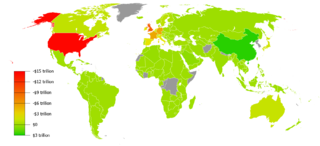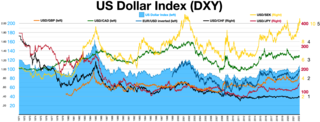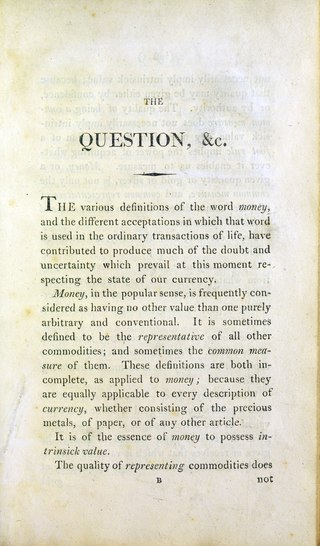
Balance of trade can be measured in terms of commercial balance, or net exports. Balance of trade is the difference between the monetary value of a nation's exports and imports over a certain time period. Sometimes a distinction is made between a balance of trade for goods versus one for services. The balance of trade measures a flow variable of exports and imports over a given period of time. The notion of the balance of trade does not mean that exports and imports are "in balance" with each other.

In economics, inflation is a general increase in the prices of goods and services in an economy. This is usually measured using the consumer price index (CPI). When the general price level rises, each unit of currency buys fewer goods and services; consequently, inflation corresponds to a reduction in the purchasing power of money. The opposite of CPI inflation is deflation, a decrease in the general price level of goods and services. The common measure of inflation is the inflation rate, the annualized percentage change in a general price index. As prices faced by households do not all increase at the same rate, the consumer price index (CPI) is often used for this purpose.
Purchasing power parity (PPP) is a measure of the price of specific goods in different countries and is used to compare the absolute purchasing power of the countries' currencies. PPP is effectively the ratio of the price of a market basket at one location divided by the price of the basket of goods at a different location. The PPP inflation and exchange rate may differ from the market exchange rate because of tariffs, and other transaction costs.

In finance, an exchange rate is the rate at which one currency will be exchanged for another currency. Currencies are most commonly national currencies, but may be sub-national as in the case of Hong Kong or supra-national as in the case of the euro.

The Monetary Authority of Singapore or (MAS), is the central bank and financial regulatory authority of Singapore. It administers the various statutes pertaining to money, banking, insurance, securities and the financial sector in general, as well as currency issuance and manages the foreign-exchange reserves. It was established in 1971 to act as the banker to and as a financial agent of the Government of Singapore. The body is duly accountable to the Parliament of Singapore through the Minister-in-charge, who is also the Incumbent Chairman of the central bank.

In international economics, the balance of payments of a country is the difference between all money flowing into the country in a particular period of time and the outflow of money to the rest of the world. In other words, it is economic transactions between countries during a period of time. These financial transactions are made by individuals, firms and government bodies to compare receipts and payments arising out of trade of goods and services.
In macroeconomics and modern monetary policy, a devaluation is an official lowering of the value of a country's currency within a fixed exchange-rate system, in which a monetary authority formally sets a lower exchange rate of the national currency in relation to a foreign reference currency or currency basket. The opposite of devaluation, a change in the exchange rate making the domestic currency more expensive, is called a revaluation. A monetary authority maintains a fixed value of its currency by being ready to buy or sell foreign currency with the domestic currency at a stated rate; a devaluation is an indication that the monetary authority will buy and sell foreign currency at a lower rate.

Strong dollar policy is United States economic policy based on the assumption that a 'strong' exchange rate of the United States dollar is in the interests of the United States. In 1971, Treasury Secretary John Connally famously remarked how the US dollar was "our currency, but your problem," referring to how the US dollar was managed primarily for the US' interests despite it being the currency primarily used in global trade and global finance. A strong dollar is recognized to have many benefits but also potential downsides. Domestically in the US, the policy keeps inflation low, encourages foreign investment, and maintains the currency's role in the global financial system. Globally, a strong dollar is thought to be harmful for the rest of the world. In financial markets, the strength of the dollar is measured in the "DXY Index", an index which measures the exchange rate of the dollar relative to other major currencies.
The Convertibility plan was a plan by the Argentine Currency Board that pegged the Argentine peso to the U.S. dollar between 1991 and 2002 in an attempt to eliminate hyperinflation and stimulate economic growth. While it initially met with considerable success, the board's actions ultimately failed. The peso was only pegged to the dollar until 2002.

Currency depreciation is the loss of value of a country's currency with respect to one or more foreign reference currencies, typically in a floating exchange rate system in which no official currency value is maintained. Currency appreciation in the same context is an increase in the value of the currency. Short-term changes in the value of a currency are reflected in changes in the exchange rate.
The trade-weighted US dollar index, also known as the broad index, is a measure of the value of the United States dollar relative to other world currencies. It is a trade weighted index that improves on the older U.S. Dollar Index by incorporating more currencies and yearly rebalancing. The base index value is 100 in January 1997. As the U.S. Dollar gains value the index increases.

The U.S. Dollar Index is an index of the value of the United States dollar relative to a basket of foreign currencies, often referred to as a basket of U.S. trade partners' currencies. The Index goes up when the U.S. dollar gains "strength" (value) when compared to other currencies.
There are two different types of world currency unit in use today that have different origins and usages.
The effective exchange rate is an index that describes the strength of a currency relative to a basket of other currencies. Typically it is calculated using geometric weighting. It can be computed using the USD as a numeraire. This means the constituent exchange rates are all first defined vis-a-vis the USD.
VND Index also known as the Trade Weighted Vietnam Dong Index, is a measure of the value of the Vietnamese đồng (VND) relative to majority of Vietnam's most significant trading partners.

A currency basket is a portfolio of selected currencies with different weightings. A currency basket is commonly used by investors to minimize the risk of currency fluctuations and also governments when setting the market value of a country's currency.
Inflation rate in India was 4.83% as of April 2024, as per the Indian Ministry of Statistics and Programme Implementation. This represents a modest reduction from the previous figure of 5.69% for December 2023. CPI for the months of January, February and March 2024 are 5.10, 5.09 and 4.85 respectively. Inflation rates in India are usually quoted as changes in the Consumer Price Index (CPI), for all commodities.
Fear of floating refers to situations where a country prefers a fixed exchange rate to a floating exchange rate regime. This is more relevant in emerging economies, especially when they suffered from financial crisis in the last two decades. In foreign exchange markets of the emerging market economies, there is evidence showing that countries who claim they are floating their currency, are actually reluctant to let the nominal exchange rate fluctuate in response to macroeconomic shocks. In the literature, this is first convincingly documented by Calvo and Reinhart with "fear of floating" as the title of one of their papers in 2000. Since then, this widespread phenomenon of reluctance to adjust exchange rates in emerging markets is usually called "fear of floating". Most of the studies on "fear of floating" are closely related to literature on costs and benefits of different exchange rate regimes.
The effective exchange rate index describes the strength of a currency relative to a basket of other currencies. Although typically the basket is trade weighted, there are others besides the trade-weighted effective exchange rate index.
The Euro Currency Index (EUR_I) represents the arithmetic ratio of four major currencies against the Euro: the American dollar, British sterling, the Japanese yen and the Swiss franc. All ratios are expressed in units of currency per Euro. The index was launched in 2004 by the exchange portal Stooq.com. Underlying are 100 points on 4 January 1971. Before the introduction of the European single currency on 1 January 1999 an exchange rate of 1 euro = DM 1.95583 was calculated.









